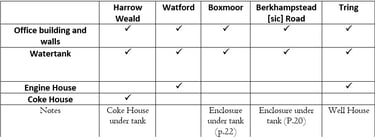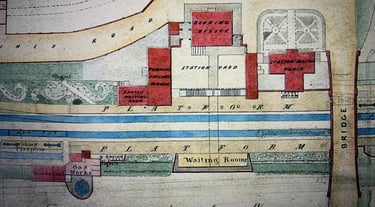The intermediate stations were quite modular initially and composed a number of specific units of passenger facilities, (booking office, waiting rooms, loos and courtyard). Loco facilities included some with he means to create coke, some to only store it, some stations had ash pits on the main line and a few select stations had an engine shed. There were no initial carriage sheds, these came in in 1840 after the effects of the weather on the carriages became more evident.
From the construction contracts held at the National Archives [ TNA RAIL 384 177/8/9, 384 180/1]


A feature of early design is that the locomotive ash pits were placed unusually on the main line. On the original line drawings[1] these are indicated by rectangle outlines adjacent to the water cranes on the stations from Euston to Tring. However on the maps for the remaining stations toward Birmingham these are absent being a detail that the draftsman or surveyor appears not to have included[2].




Tring, with detail showing the ‘ASH PIT’ written. Courtesy of Russell Burridge and hosted on https://tringlocalhistory.org.uk/Railway_local/index.htm
Wolverton was obviously an exception, being the half way point on the line and the main locomotive servicing point and works.
Luggage and Parcel facilities were virtually non-existent at intermediate stations, although these would develop later. A number of stations had many stairs and the movement of luggage was an issue in the early period and was revised several times as things developed.
Single sided stations
The directors experimented initially with the idea of the intermediate stations being as much as possible on one side of the line. This was not an absolute rule, for example Coventry’s engine shed was the other side of the tracks, although at Tring, Boxmoor and Watford, for example, this was the case. In accordance with this concept there were only platforms on one side of the stations. The platforms were all on the up or London side.
At Euston and Curzon Street platforms were not dissimilar to modern ones in height but on the intermediate stations the platforms were either paving, just above the ground level, and in some other cases wood platforms were provided. There were obviously two issues with this early arrangement, firstly the low level paving wasn’t particularly long and you still had to step up to the carriage as in entering a road coach. The other problem was that passengers were required to cross the tracks to enter trains on the down side, to Birmingham.
